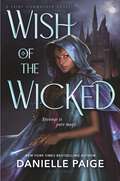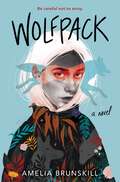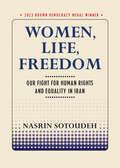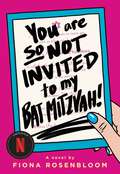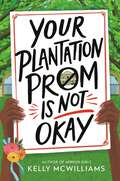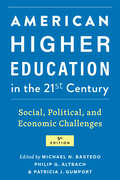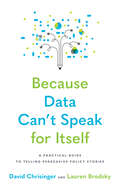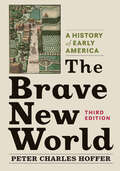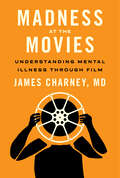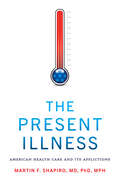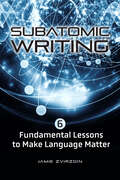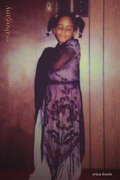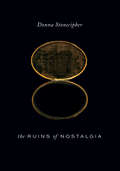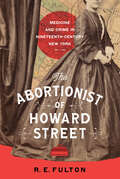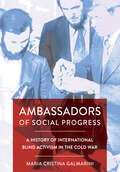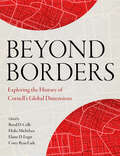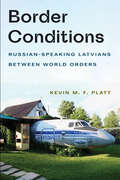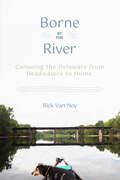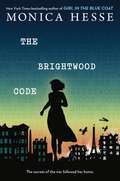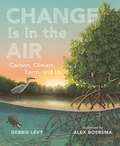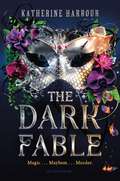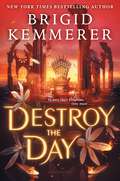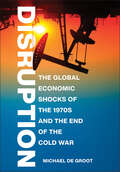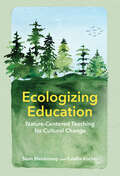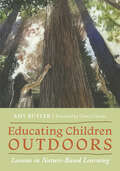- Table View
- List View
Wish of the Wicked (A Fairy Godmother Novel)
by Danielle PaigeNew York Times bestselling author Danielle Paige puts a dark YA spin on Cinderella's fairy godmother in this brand new origin story, perfect for fans of These Violent Delights and A Curse So Dark and Deadly.Everyone knows a fairy godmother helped Cinderella get to the ball. But no one knows why. For centuries, Farrow's family-the Entente-have been magical advisors to the Queen. Their wisdom and foresight kept the Thirteen Queendoms in harmony. Until a new queen, Magrit, takes power, outlaws magic, and executes the Entente. Only Farrow survives, with her magic warped beyond repair. She can now use it only to fulfill the feeble wishes of commoners.Since that day, Farrow has dreamed of revenge. The one way to reach the queen is through her son, Prince Mather, who is nearing the age when he must select a bride. When a special ball in his honor is announced, Farrow sees her opportunity. All it will take is a young woman named Cinderella who dreams of true love. With one night, one chance to reclaim her magic and destroy the queen, Farrow will stop at nothing.Set in a lush, dangerous world rooted in our beloved fairy tales, New York Times bestselling author Danielle Paige launches a brand-new Fairy Godmother origin story full of intrigue, magic, and romance.
Wolfpack
by Amelia BrunskillThis shocking, suspenseful novel about a group of teenage girls living in a cult reveals the terrifying paranoia and suspicion that emerges when one of them goes missing– perfect for fans of We Were Liars. Nine girls bound together in beautiful, virtuous Havenwood, a refuge from an unsafe world. Then there are eight one of them gone — departed with no warning. Did this member of their pack stray willingly, or did something more sinister occur? The girls seek answers not knowing if they should be angry or frightened or perhaps, they should be both.
Women, Life, Freedom: Our Fight for Human Rights and Equality in Iran (Brown Democracy Medal)
by Nasrin SotoudehThe Laurence and Lynne Brown Democracy Medal, presented by the McCourtney Institute for Democracy at Penn State, recognizes outstanding individuals, groups, and organizations that produce innovations to further democracy in the United States or around the world.Nasrin Sotoudeh is an Iranian lawyer and human rights activist who has been called "Iran's Nelson Mandela." Sotoudeh is a longtime opponent of the death penalty, advocate of improving imprisonment health conditions, and an activist dedicated to fighting for the rights of women, children, religious and ethnic minorities, journalists and artists, and those facing execution. As a result of her advocacy, Sotoudeh has been repeatedly imprisoned by the Iranian government for crimes against the state; she served one sentence from 2010 to 2013 and was sentenced again in 2018 to thirty-eight years and six months in prison and 148 lashes. Her work has been featured in the 2020 documentary Nasrin, by filmmakers Jeff Kaufman and Marcia S. Ross. For this important work, she is the recipient of the 2023 Brown Democracy Medal from the McCourtney Institute for Democracy, marking the award's tenth year.
You Are So Not Invited to My Bat Mitzvah!
by Fiona RosenbloomSoon to be a Netflix film featuring Adam Sandler! Stacy Friedman is getting ready for one of the most important events of her young life - her bat mitzvah. All she wants is the perfect dress to wear, her friends by her side, and her biggest crush ever, Andy Goldfarb, to dance with her (and maybe even make out with her on the dance floor). But Stacy's well-laid plans quickly start to fall apart... Her stressed-out mother forces her to buy a hideous sequined dress that makes her look like the bride of Frankenstein. Her mitzvahs are not going well at all. And then the worst thing in the entire world happens causing Stacy to utter the words that will wreak complete havoc on her social life: You are SO not invited to my bat mitzvah!
Your Plantation Prom Is Not Okay
by Kelly McWilliamsThis sharp-witted, timely novel explores cancel culture, anger, and grief, and challenges the romanticization of America's racist past with humor and heart—for readers of Dear Martin by Nic Stone and Grown by Tiffany D. Jackson. Harriet Douglass lives with her historian father on an old plantation in Louisiana, which they&’ve transformed into one of the South's few enslaved people&’s museums. Together, while grieving the recent loss of Harriet&’s mother, they run tours that help keep the memory of the past alive. Harriet's world is turned upside down by the arrival of mother and daughter Claudia and Layla Hartwell—who plan to turn the property next door into a wedding venue, and host the offensively antebellum-themed wedding of two Hollywood stars. Harriet&’s fully prepared to hate Layla Hartwell, but it seems that Layla might not be so bad after all—unlike many people, this California influencer is actually interested in Harriet's point of view. Harriet's sure she can change the hearts of Layla and her mother, but she underestimates the scale of the challenge… and when her school announces that prom will be held on the plantation, Harriet&’s just about had it with this whole racist timeline! Overwhelmed by grief and anger, it&’s fair to say she snaps. Can Harriet use the power of social media to cancel the celebrity wedding and the plantation prom? Will she accept that she&’s falling in love with her childhood best friend, who&’s unexpectedly returned after years away? Can she deal with the frustrating reality that Americans seem to live in two completely different countries? And through it all, can she and Layla build a bridge between them?
American Higher Education in the Twenty-First Century: Social, Political, and Economic Challenges
by Michael N. Bastedo Philip G. Altbach Patricia J. GumportNow in its fifth edition! An indispensable reference for anyone concerned with the future of American colleges and universities.Whether it is advances in information technology, organized social movements, or racial inequality and social class stratification, higher education serves as a lens for examining significant issues within American society. First published in 1998, American Higher Education in the Twenty-First Century offers a comprehensive introduction to the complex realities of American higher education, including its history, financing, governance, and relationship with the states and federal government. This thoroughly revised edition brings the classic volume completely up to date. Each chapter has been rewritten to address major recent issues in higher education, including the COVID-19 pandemic, the movement for racial justice, and turmoil in the for-profit sector. Three entirely new chapters cover broad-access colleges, race and racism, and organized social movements. Reflecting on the implications of ethnic and socioeconomic diversity within higher education, the book also grapples with growing concerns about the responsiveness and future of the academy.No other book covers such wide-ranging issues under the broader theme of higher education's relationship to society. Highly acclaimed and incorporating cutting-edge research, American Higher Education in the Twenty-First Century is now more useful and engaging than ever.Contributors: Michael N. Bastedo, Philip G. Altbach, Patricia J. Gumport, Peter Riley Bahr, Joy Blanchard, Julia Brickfield, Michael Brown, Katherine S. Cho, Daniela Conde, Charles H. F. Davis III, Hans de Wit, Peter D. Eckel, Martin Finkelstein, Denisa Gándara, Liliana M. Garces, Roger L. Geiger, Leslie D. Gonzales, Jillian Leigh Gross, Jessica Harris, Nicholas Hillman, Julia Rose Karpicz, Robert Kelchen, Adrianna Kezar, Lisa R. Lattuca, Demetri Morgan, Rebecca Natow, Anna Neumann, Audrey Peek, Laura W. Perna, Gary Rhoades, Tykeia N. Robinson, Roman Ruiz, Wonson Ryu, Lauren T. Schudde, Jeffrey C. Sun, David A. Tandberg
Because Data Can't Speak for Itself: A Practical Guide to Telling Persuasive Policy Stories
by David Chrisinger Lauren BrodskyA guide for how to tell clear, data-driven stories that will make an impact.People with important evidence-based ideas often struggle to translate data into stories their readers can relate to and understand. And if leaders can't communicate well to their audience, they will not be able to make important changes in the world. Why do some evidence-based ideas thrive while others die? And how do we improve the chances of worthy ideas? In Because Data Can't Speak for Itself, accomplished educators and writers David Chrisinger and Lauren Brodsky tackle these questions head-on. They reveal the parts and functions of effective data-driven stories and explain myriad ways to turn your data dump into a narrative that can inform, persuade, and inspire action. Chrisinger and Brodsky show that convincing data-driven stories draw their power from the same three traits, which they call people, purpose, and persistence. Writers need to find the real people behind the numbers and share their stories. At the same time, they need to remember their own purpose and be honest about what data says—and, just as importantly, what it does not. Compelling and concise, this fast-paced tour of success stories—and several failures—includes examples on topics such as COVID-19, public diplomacy, and criminal justice. Chrisinger and Brodsky's easy-to-apply tool kit will turn anyone into an effective and persuasive evidence-based writer. Aimed at policy analysts, politicians, journalists, teachers, and business leaders, Because Data Can't Speak for Itself will transform the way you communicate ideas.
The Brave New World: A History of Early America
by Peter Charles HofferA lively synthesis of early American history, now in its third edition.The Brave New World covers the entire span of early American history, from 30,000 years before Europeans landed on North American shores to the Revolutionary War. With its exploration of the places and peoples of early America, this comprehensive new edition of a classic textbook brings together the most recent scholarship on the colonial and revolutionary eras, Native Americans, slavery and the slave trade, politics, war, and the daily lives of ordinary people.In this edition, Peter Charles Hoffer incorporates the wealth of innovative work on early American history, including fresh material on• environmental history• the Dutch and French Caribbean• Indigenous societies• consumer goods• mapping• captivity tales• settler imperialism• power—who has it, who wants it, how it is expressed, and how it is opposedEmphasizing how diverse and entangled the early American imperial world was, this edition also greatly expands the geographical scope of the book. An updated bibliographic essay offering short descriptions of relevant books, articles, collections, and anthologies rounds out the volume. Wide-ranging and inclusive, The Brave New World continues to provide students, instructors, and historians with an engaging and accessible history of early North America.
Madness at the Movies: Understanding Mental Illness through Film
by James CharneyA unique exploration of how mental illness is portrayed in classic and contemporary films.The study of classic and contemporary films can provide a powerful avenue to understand the experience of mental illness. In Madness at the Movies, James Charney, MD, a practicing psychiatrist and long-time cinephile, examines films that delve deeply into characters' inner worlds, and he analyzes moments that help define their particular mental illness. Based on the highly popular course that Charney taught at Yale University and the American University of Rome, Madness at the Movies introduces readers to films that may be new to them and encourages them to view these films in an entirely new way. Through films such as Psycho, Taxi Driver, Through a Glass Darkly, Night of the Hunter, A Woman Under the Influence, Ordinary People, and As Good As It Gets, Charney covers an array of disorders, including psychosis, paranoia, psychopathy, depression, bipolar disorder, obsessive-compulsive disorder, and anxiety. He examines how these films work to convey the essence of each illness. He also looks at how each film reflects the understanding of mental illness at the time it was released as well as the culture that shaped that understanding.Charney explains how to observe the behaviors displayed by characters in the films, paying close attention to signs of mental illness. He demonstrates that learning to read a film can be as absorbing as watching one. By viewing these films through the lens of mental health, readers can hone their observational skills and learn to assess the accuracy of depictions of mental illness in popular media.
The Present Illness: American Health Care and Its Afflictions
by Martin F. ShapiroBeyond political posturing and industry quick-fixes, why is the American health care system so difficult to reform?Health care reform efforts are difficult to achieve and have been historically undermined by their narrow scope. In The Present Illness, Martin F. Shapiro, MD, PhD, MPH, weaves together history, sociology, extensive research, and his own experiences as a physician to explore the broad range of afflictions impairing US health care and explains why we won't be able to fix the system without making significant changes across society. With a sharp eye and ready humor, Shapiro dissects the ways all groups participating—clinicians and their organizations, medical schools and their faculty, hospitals and clinical corporations, scientists and the National Institutes of Health, insurers and manufacturers, governments and their policies, and also patients and the public—shape and reinforce a dysfunctional system. Shapiro identifies three major problems stymieing reform: commodification of care; values, expectations, unmet needs, attitudes, and personal limitations of participants; and toxic relationships and communication among these groups.Shapiro lays out a sweeping agenda of concrete actions to address the many factors contributing to the system's failings. Highlighting the interconnectedness of both the problems and potential solutions, he warns that piecemeal reform efforts will continue to be undermined by those who believe they have something to gain from the status quo. Although overhauling our health care system is daunting, Shapiro nonetheless concludes that we must push forward with a far more comprehensive effort in all sectors of health care and throughout society to create a system that is humane, effective, and just.
Subatomic Writing: Six Fundamental Lessons to Make Language Matter
by Jamie ZvirzdinSee science writing fundamentals afresh through a subatomic lens!In Subatomic Writing, Johns Hopkins University instructor Jamie Zvirzdin goes bravely into uncharted territory by offering a totally new kind of guide for writing about science—from the subatomic level up! Subatomic Writing teaches readers that the building blocks of language are like particles in physics. These particles, combined and arranged, form something greater than their parts: all matter in the literary universe. The six levels of language covered in this guide create writing that illuminates and energizes the reader to feel, learn, change, and act. This interdisciplinary approach helps scientists, science writers, and editors improve their writing in fundamental areas as they build from the sounds in a word to the pacing of a paragraph. These areas include• Sound and sense• Word classes• Grammar and syntax• Punctuation• Rhythm and emphasis• Pacing and coherenceEqually helpful for students who need to learn how to write clearly about science and scientists who need to hone their writing skills to create more effective course material, papers, and grant applications, this guide builds confidence in writing abilities as old skills are taught in new, exciting ways. Each lesson provides exercises that build on each other, strengthening readers' capacity to communicate ideas and data, all while learning basic particle physics along the way.
mahogany (Wesleyan Poetry Series)
by erica lewismahogany takes its name from the dark wood prized for its durability, workability, and elegant look, and from the Diana Ross movie, whose theme song asks if what lies ahead is what you really want. This book is the third in a trilogy, and like the first two books it is steeped in pop music. Each poem here takes its title from a line of a Diana Ross and The Supremes song, as well as songs from Diana Ross' solo career. Short lines flow down the page like postmodern psalms, connecting dailyness to timelessness, merging the historical and the beloved through reverence for family, music, and the life we actually live. mahogany is a lament for the passing of time and unimaginable loss, and at the same time it models the daily search for joy, and the deep shine that can arise from the darkest times.[sample poem]i'm like a woman who once knew splendor* sometimes i feel like the pink pantherall naked and pinklost in the morass ofdo the best you can todayand nigga heal thy selfour end of winterspirits breaklike old tibetan snowi rememberyou was conflictedand i found myself alonehere on my ancient hurtthe disquieting humof living historydear god, pleaseput my head above my heartwe can only be togetherif the stories are toldplain facesame instrumentjust a couple of coke bottlesfull of gasolinelike god and rainis a waste of timemy mother used to clean housesas a childsome days i can barelyget out of bedin my mindshe's like diana rossscrubbing the white lady's stairsin lady sings the bluesexcept prettierand with green eyesi've just been livingoff of cough dropsand water and angerjust sitting in the whole foodsparking lot eating pineapplei am literallythe definition of "hot mess"pain changes everythingsomebody comeand pick upmy limp bodyoff the groundi am dyinga slow ohio deathwe miss you starmanit's our first sunrise of the burn* "dark side of the world"erica lewis
The Ruins of Nostalgia (Wesleyan Poetry Series)
by Donna StonecipherWhat is it to feel nostalgia, to be skeptical of it yet cleave intently to the complex truths of feeling and thought? In a series of 64 gorgeous, ramifying, unsettling prose poems addressing late-twentieth- and twenty-first century experience and its discontents, The Ruins of Nostalgia offers a strikingly original exploration of the misunderstood phenomenon of nostalgia as both feeling-state and historical phenomenon. Each poem, also titled The Ruins of Nostalgia, is a kind of lyrical mini-essay, playful, passionate, analytic. Some poems take a location, memory, conceit, or object as their theme. Throughout the series, the poems recognize and celebrate the nostalgias they ironize, which are in turn celebrated and then ironized again. Written often in the fictional persona of the first-person plural, The Ruins of Nostalgia explores the rich territory where individual response meets a collective phenomenon.[sample poem]The Ruins of Nostalgia 13Where once there had been a low-end stationery store minded by an elderly beauty queen, there was now a store for high-end espresso machines minded by nobody. Where once there had been an illegal beer garden in a weedy lot, there was now a complex of luxury lofts with Parisian-style ivory façades. Where once there had been a bookstore and a bike shop and a bakery, there was now a wax museum for tourists. Where once there had been an empty lot there was now a building. Where once there had been an empty lot there was now a building. Where once there had been an empty lot there was now a building. Where once there had been an empty lot there was now a building. Where once there had been farms there were now subdivisions. Where once there had been subdivisions there were now sub-subdivisions. We lived in a sub-subdivision of a subdivision. We ourselves had become subdivided—where once we had merely been of two minds. * Where once there had been a river there was now a road. A vocal local group had started a movement to break up the road and "daylight" the river, which still flowed, in the dark, underneath the road. * Could we daylight the farms, the empty lots, the stationery store, the elderly beauty queen, the city we moved to? Was it still flowing somewhere, under the luxury lofts, deliquescing in the dark, inhabited by our luxury selves, not yet subdivided, because not yet whole? * Could we daylight the ruins of nostalgia?
The Abortionist of Howard Street: Medicine and Crime in Nineteenth-Century New York
by R.E. FultonJosephine McCarty had many identities. But in Albany, New York, she was known as "Dr. Emma Burleigh," the abortionist of Howard Street.On January 17, 1872, McCarty boarded a streetcar in Utica, New York, shot her ex-lover in the face, and disembarked, unaware that her bullet had passed through her target's head and into the heart of the innocent man sitting beside him. The unlucky passenger died within minutes. Josephine McCarty was arrested for attempted murder and quickly became the most notorious woman in central New York. The Abortionist of Howard Street was, however, far more than a murderer. In Maryland she was "Johnny McCarty," a blockade runner and spy for Confederate forces. New Yorkers whispered of her as a mistress to corrupt Albany politicians. So who was she?The prosecution in her murder trial claimed she was a calculating and heartless operative both in the bedroom and in her public life. Or was she the victim of ill fortune and the systemic weight of misogyny and male violence? The answer, of course, was not as simple as either narrative. In this absorbing and rich history, R.E. Fulton considers the nuances of Josephine McCarty's life from marriage to divorce, from financial abuse to quarrels with intimate partners and more, trying to decipher the truth behind the stories and myths surrounding McCarty and what ultimately led her to that Utica streetcar with a pistol in her dress pocket. In The Abortionist of Howard Street, Fulton revisites a rich history of women's experience in mid-nineteenth century America, revealing McCarty as a multifaceted, fascinating personification of issues as broad as reproductive health, education, domestic abuse, mental illness, and criminal justice.
Ambassadors of Social Progress: A History of International Blind Activism in the Cold War (NIU Series in Slavic, East European, and Eurasian Studies)
by Maria Cristina GalmariniAmbassadors of Social Progress examines the ways in which blind activists from the Soviet Union and Eastern Europe entered the postwar international disability movement and shaped its content and its course. Maria Cristina Galmarini shows that the international work of socialist blind activists was defined by the larger politics of the Cold War and, in many respects, represented a field of competition with the West in which the East could shine. Yet, her study also reveals that socialist blind politics went beyond propaganda. When socialist activists joined the international blind movement, they initiated an exchange of experiences that profoundly impacted everyone involved. Not only did the international blind movement turn global disability welfare from philanthropy to self-advocacy, but it also gave East European and Soviet activists a new set of ideas and technologies to improve their own national movements. By analyzing the intersection of disability and politics, Ambassadors of Social Progress enables a deeper, bottom-up understanding of cultural relations during the Cold War. Galmarini significantly contributes to the little-studied history of disability in socialist Europe, and ultimately shows that disability activism did not start as an import from the West in the post-1989 period, but rather had a long and meaningful tradition that was rooted in the socialist system of welfare and needed to be reinvented when this system fell apart.
Beyond Borders: Exploring the History of Cornell's Global Dimensions
by Royal D. Colle, Heike Michelsen, Elaine D. Engst and Corey Ryan EarleBeyond Borders highlights and celebrates Cornell University's many historical achievements in international activities going back to its founding. This collection of fifty-eight short chapters reflects the diversity, accomplishments, and impact of remarkable engagements on campus and abroad. These vignettes, many written by authors who played pivotal roles in Cornell's international history, take readers around the world to China and the Philippines with agricultural researchers, to Peru with anthropologists, to Qatar and India with medical practitioners, to Eastern Europe with economists and civil engineers, to Zambia and Sierra Leone with students and Peace Corps volunteers, and to many more places. Readers also will learn about Cornell's many international dimensions on campus, including the international studies and language programs and the library and museum collections. Beyond Borders captures how—by educating generations of global citizens, producing innovative research and knowledge, building institutional capacities, and forging mutually beneficial relationships—Cornell University has influenced positive change in the world.Beyond Borders was supported by CAPE (Cornell Academics and Professors Emeriti).
Border Conditions: Russian-Speaking Latvians between World Orders (NIU Series in Slavic, East European, and Eurasian Studies)
by Kevin M. PlattBorder Conditions combines history and memory studies with literary and cultural studies to examine lives at the limits of contemporary Europe: Russian speakers living in Latvia. Since the fall of the USSR in 1991, Latvia's Russian speakers have balanced between Russia and Europe as well as a socialist past, a capitalist and liberal present, and an illiberal regime rising in the Russian Federation. Kevin M. F. Platt describes how members of this population have defined themselves through art, literature, cultural institutions, film, and music—and how others have sought to define them. At the end of the Cold War, many anticipated that societies globally could agree on the meaning of past history and a just politics in the present. The view from the borders of Europe demonstrates the contradictions pertaining to terms like empire, state socialism, liberalism, and nation that have made it impossible to achieve a consensus. In refocusing the examination of state socialism's aftermath around questions of empire and postcolonialism, Border Conditions helps us understand the distinctions between Russian and Western worldviews driving military confrontation to this day.
Borne by the River: Canoeing the Delaware from Headwaters to Home
by Rick Van NoyAfter a near-fatal stroke and a separation, amidst a global pandemic, Rick Van Noy decided to go for a paddle. In Borne by the River, he charts the story of discovery, and healing that came from this solo canoe journey. Paddling two hundred miles on the Delaware River to his boyhood home just upriver from Trenton, New Jersey, Van Noy contemplates his fate and life, as well as the simple joy of sitting in a small boat floating down a large river with his dog, Sully.Deftly combining memoir, natural and local history, and engaging reportage of his encounters with other paddlers and river enthusiasts, including members of the Lenape Nation of Pennsylvania, Van Noy reveals deep and shifting layers of environmental, historical, cultural, and personal significance of the Delaware. Borne by the River reckons with the way that rivers braid into one's own life—thrilling rapids, eddying pauses, and life-changing rifts and falls. Van Noy rediscovers and shares how river journeys can scatter anxieties, wash away regrets, and recreate the spirit in its free-flowing currents.
The Brightwood Code
by Monica HesseIn a breathless, haunting, and rich historical mystery, New York Times bestselling author Monica Hesse speaks to the depths of trauma and the power of memory. Seven months ago, Edda was on the World War I front lines as one of two hundred &“Hello Girls,&” female switchboard operators employed by the US Army. She spent her nights memorizing secret connection codes to stay ahead of spying enemies, and her days connecting vital calls between platoons and bases and generals, all trying to survive—and win—a brutal war. Their lives were in Edda&’s hands, and one day, in fateful seconds, everything went wrong. Now, Edda is back in Washington, DC, working as an American Bell Telephone operator, the picture of respectability. But when her shift ends, Edda is barely hanging on, desperate to forget the circumstances that cut her time overseas short. When Edda receives a panicked phone call from someone who utters the fateful code word &“Brightwood,&” she has no choice but to confront her past. With precious few clues and help only from Theo, a young man bearing his own WWI scars, Edda races to uncover what secrets may have followed her across the ocean. Timely and unforgettable,The Brightwood Code sheds light on hidden history and the brutality of being a woman in a war built by men.
Change Is in the Air: Carbon, Climate, Earth, and Us
by Debbie LevyA nonfiction picture book about amazing ways that the Earth removes carbon from the air, and amazing ways people can help, offering a fresh and hopeful perspective on climate change.The Earth has a problem: there's too much carbon in the air. Luckily, the Earth also has amazing powers to remove carbon dioxide from the atmosphere-like the power of kelp, mangroves, and dirt. Although these powers alone cannot get us out of the climate crisis we're facing, the Earth has another important power: the power of people! People have the power to change, protect, innovate, and invent. In this informational picture book, Debbie Levy and Alex Boersma paint an encouraging yet honest picture of the problems at hand and some of the ways that we can address them. Thanks to the power of nature and the ingenuity of people, change is in the air!
The Dark Fable
by Katherine HarbourMagical heists. Deadly secrets. Come along for the ride . . . if you dare. This heart-stopping, seductive fantasy is perfect for fans of Six of Crows.Evie Wilder is an orphan who has gone through most of her life unnoticed . . . until she's caught up in a dramatic heist and captures the attention of the Dark Fable. They have chosen her for a reason: she can turn invisible. This skill would make Evie a treasured asset to the legendary group of thieves known for spiriting away obscure and occult artifacts.Evie cannot resist their allure and is eager to join this newfound family. But she discovers there are more skeletons in the Dark Fable's past than she could have ever imagined. And these secrets might be the answer to her own tragic past.No one is who they seem to be and the price of uncovering the Dark Fable's cryptic history just might be fatal . . .
Destroy the Day (Defy the Night #3)
by Brigid KemmererIn the thrilling conclusion to the Defy the Night series, New York Times bestselling author Brigid Kemmerer crafts heartrending twists and devastating turns that will keep readers breathless to the very end.Left for dead, but desperate to survive . . . they have one last chance to save their kingdom. Prince Corrick is out of options. Held captive by the vicious Oren Crane, he's desperate to reunite with Tessa, but will need to ally with the rebel leader Lochlan, who until now wished him dead. An unlikely but deadly pair, Corrick and Lochlan must plot their next moves carefully. . . An island away, Tessa Cade is heartbroken and angry. Grieving Corrick, and unsure how to find a way back to Kandala, she doesn't know who to trust. Until Rian--the man she trusts least--makes an offer: aid in a plot to finally oust Oren Crane and see what the future holds. . . Meanwhile in Kandala, Harristan is dethroned and on the run. He's struggling to unite the rebels in his fractured kingdom, but he finds support--and maybe more--in unexpected places.Can Harristan be the king his people need? Can Corrick and Tessa find their way back to each other? As outside threats loom and the fires of revolution burn from within, time is running out to save their kingdom.
Disruption: The Global Economic Shocks of the 1970s and the End of the Cold War
by Michael De GrootIn Disruption, Michael De Groot argues that the global economic upheaval of the 1970s was decisive in ending the Cold War. Both the West and the Soviet bloc struggled with the slowdown of economic growth; chaos in the international monetary system; inflation; shocks in the commodities markets; and the emergence of offshore financial markets. The superpowers had previously disseminated resources to their allies to enhance their own national security, but the disappearance of postwar conditions during the 1970s forced Washington and Moscow to choose between promoting their own economic interests and supporting their partners in Europe and Asia. De Groot shows that new unexpected macroeconomic imbalances in global capitalism sustained the West during the following decade. Rather than a creditor nation and net exporter, as it had been during the postwar period, the United States became a net importer of capital and goods during the 1980s that helped fund public spending, stimulated economic activity, and lubricated the private sector. The United States could now live beyond its means and continue waging the Cold War, and its allies benefited from access to the booming US market and the strengthened US military umbrella. As Disruption demonstrates, a new symbiotic economic architecture powered the West, but the Eastern European regimes increasingly became a burden to the Soviet Union. They were drowning in debt, and the Kremlin no longer had the resources to rescue them.
Ecologizing Education: Nature-Centered Teaching for Cultural Change
by Sean Blenkinsop Estella C. KuchtaEcologizing Education explores how we can reenvision education to meet the demands of an unjust and rapidly changing world. Going beyond "green" schooling programs that aim only to shape behavior, Sean Blenkinsop and Estella Kuchta advance a pedagogical approach that seeks to instills eco-conscious and socially just change at the cultural level. Ecologizing education, as this approach is called, involves identifying and working to overcome anti-ecological features of contemporary education. This approach, called ecologizing education, aims to develop a classroom culture in sync with the more-than-human world where diversity and interdependency are intrinsic.Blenkinsop and Kuchta illustrate this educational paradigm shift through the real-world stories of two public elementary schools located in British Columbia. They show that this approach to learning starts with recognizing the environmental and social injustices that pervade our industrialized societies. By documenting how ecologizing education helps children create new relationships with the natural world and move toward mutual healing, Blenkinsop and Kuchta offer a roadmap for what may be the most potent chance we have at meaningful change in the face of myriad climate crises. Timely, practical, and ultimately inspirational, Ecologizing Education is vital reading for any parent, caregiver, environmentalist, or educator looking for wholistic education that places nature and the environment front and center.
Educating Children Outdoors: Lessons in Nature-Based Learning
by Amy ButlerEducating Children Outdoors is a resource for educators interested in spending extended periods of time in nature with their students. Bringing over two decades of experience working outdoors with teachers and students, Amy Butler offers curricular guidance on nature-based lessons that align with K–12 education standards and build on the innate curiosity and wonder children have for the natural world. This book will help the educator:- Learn successful routines and practices to make learning outdoors safe and engaging- Understand protocols for real and risky play- Draw inspiration from real-life stories from other teachers about learning in nature- Meet NGSS and Common Core standards outdoors with seasonal lessons that are child-centered- Be part of the movement to support children in becoming reconnected with the natural world and the places they call homeWith twenty-five lessons in five units of study spread out across a seasonal school year and appendixes that offer templates for learning, Educating Children Outdoors is essential for educators looking to harvest the benefits of a nature-based curriculum.
